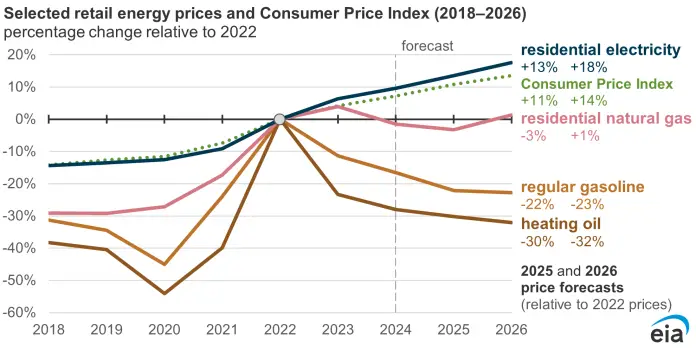Retail electricity prices have become a growing concern for small business owners, particularly in regions where these costs are climbing faster than inflation. According to the U.S. Energy Information Administration (EIA), a new report reveals that, since 2022, retail electricity prices have outpaced inflation, with projections indicating a continued upward trend through 2026. This trend presents both challenges and opportunities for small businesses navigating their energy expenses.
The EIA’s latest Short-Term Energy Outlook forecasts a national average increase in retail electricity prices of approximately 13% from 2022 to 2025. Regions that already experience high electricity costs, such as the Pacific, Middle Atlantic, and New England, are expected to see price hikes exceeding this national average. For small businesses operating in these areas, this spell of increasing costs can significantly impact their bottom line.
As economic recovery from the pandemic unfolds, various factors have contributed to rising energy prices, notably Russia’s invasion of Ukraine, which disrupted global energy supply chains. While prices for some fuels, like gasoline and heating oil, have declined due to their ties to crude oil, electricity prices have continued their steady ascent. This disconnect creates a unique scenario where small businesses must adapt to fluctuating energy expenses that do not necessarily correlate with other fuel costs.
Electricity prices encapsulate more than just the cost of generation; they also include transmission and delivery fees along with additional taxes. With electric utilities ramping up capital investments for infrastructure upgrades—aimed at replacing aging systems—businesses are seeing the direct impact of these expenses reflected in their service bills. As utilities shift focus toward distribution spending, it will affect how electricity is priced moving forward.
For many small businesses, electricity expenditures represent one of the largest operational costs. According to EIA data, the average consumer spent approximately $1,760 on electricity in 2023, second only to gasoline expenditures, which averaged nearly $2,450 during the same period. Although electricity prices tend to be more stable than gasoline, the forecasted increases pose a pressing concern for budgeting and cash flow management.
Small business owners might consider several strategies to manage these rising costs. Investing in energy-efficient appliances and technologies can reduce overall consumption, leading to significant savings over time. Additionally, engaging in demand-response programs or exploring renewable energy options, such as solar panels, can mitigate exposure to volatile electricity prices.
Despite these potential solutions, the transition to energy-efficient practices can initially require significant investment. Many small businesses may face budget constraints that make it difficult to implement these technologies upfront. Moreover, understanding the complexities of utility tariffs and navigating changes in pricing structures demands careful consideration and planning.
As EIA Principal Contributor Owen Comstock notes, "Electricity prices are set to increase faster than the rate of inflation, particularly in regions already burdened with high costs." This situation serves as a wake-up call for small business owners to reevaluate their energy strategies and consider proactive measures to shield themselves from the anticipated price hikes.
Busier than ever, small business owners must not only monitor rising electricity prices but also act decisively to mitigate their impacts. By leveraging available resources, investing in efficiency, and possibly even participating in collective purchasing agreements with other local businesses, they can create a more sustainable energy strategy.
In a landscape where energy costs are climbing faster than inflation, small business owners are encouraged to stay informed, adapt, and strategize accordingly. For further insights, view the full analysis from the EIA here.
Image Via US Energy



